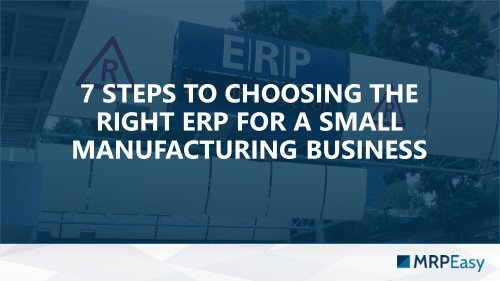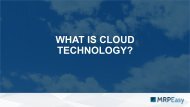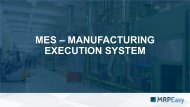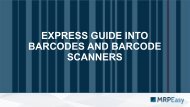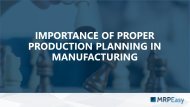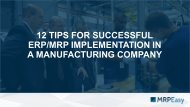7 Steps to Choosing the Right ERP for a Small Manufacturing Company
You also want an ePaper? Increase the reach of your titles
YUMPU automatically turns print PDFs into web optimized ePapers that Google loves.
7 STEPS TO CHOOSING THE<br />
RIGHT <strong>ERP</strong> FOR A SMALL<br />
MANUFACTURING BUSINESS
1. BUDGET<br />
It is true, that <strong>the</strong>re are solutions which can charge hundreds of thousands <strong>for</strong> a license and<br />
implementation, but this does not mean, that small and midsize businesses cannot af<strong>for</strong>d an <strong>ERP</strong>.<br />
However, <strong>the</strong> chance is high that expensive systems used by big corporations will be useless <strong>to</strong> SMB’s.<br />
How <strong>to</strong> define <strong>the</strong> budget?<br />
The rule of thumb is <strong>to</strong> calculate all <strong>the</strong> costs (both direct and indirect) associated with an <strong>ERP</strong> <strong>for</strong> two<br />
years of operation.<br />
Number of users<br />
Ano<strong>the</strong>r variable that defines <strong>the</strong> budget is <strong>the</strong> number of expected users, which can be calculated by<br />
taking <strong>the</strong> number of people in your office and adding one additional user per shift.
2. BUY-OUT (LICENSING) VS SUBSCRIPTION<br />
There are two main pricing options <strong>to</strong> select from when deciding on <strong>the</strong> budget:<br />
1. Buying a license, or<br />
2. Sticking with monthly (or annual) subscription plan. Both options have cons and pros.<br />
For example, on-premises software providers usually offer licensing. If selecting this option, one must<br />
be aware, that on-premises vendors often have several fees which are not always obvious at <strong>the</strong><br />
beginning (setup, software updates, software maintenance, additional infrastructure, cus<strong>to</strong>mization,<br />
support, or privileged support, etc.).<br />
Whereas subscription model is popular among Software-as-a-Service solutions where you pay only if<br />
you use <strong>the</strong> software. Usually in this case <strong>the</strong> pricing policy is more transparent (also means<br />
predictable) and also flexible.
3. SAAS (CLOUD) VS ON-PREMISES<br />
During <strong>the</strong> recent years we have witnessed a trend of SaaS solutions reasonably becoming increasingly<br />
popular. The advantages are obvious:<br />
• No need <strong>to</strong> install anything (and pay <strong>for</strong> <strong>the</strong> installation)<br />
• You can access your <strong>ERP</strong> anywhere, from any device, which allows mobility<br />
• No need <strong>to</strong> keep <strong>the</strong> software up-<strong>to</strong>-date<br />
• No need <strong>for</strong> additional infrastructure (own servers)<br />
However, <strong>the</strong>re are some scenarios where on-premises software is still <strong>the</strong> only option since:<br />
• Having <strong>the</strong> software and database on own servers could be more<br />
• Internet access is still not always available in rural areas
4. FUNCTIONALITY<br />
Apparently, if you are a manufacturer <strong>the</strong>n not every <strong>ERP</strong> will suite your needs and not every <strong>ERP</strong><br />
claiming <strong>to</strong> have a focus on manufacturing can offer functionality particularly required in<br />
manufacturing, such as production planning and scheduling and equipment load charts, as an<br />
example.<br />
No one knows your business as well as you do, so think of functions which are of primary importance<br />
<strong>for</strong> you, make a list and start searching <strong>for</strong> a manufacturing <strong>ERP</strong> which meets <strong>the</strong>se requirements.<br />
You can also put down some good-<strong>to</strong>-have features (like integration with <strong>the</strong> accounting software you<br />
already use) – <strong>the</strong>se will help you out when you already have a list of candidates offering <strong>the</strong> same<br />
main functionality.
5. PRE-SELECTION PROCESS<br />
When you follow <strong>the</strong> steps above, <strong>the</strong>n you will get a list of 4-5 <strong>ERP</strong> vendors which answer your basic<br />
needs in terms of main functionality, plat<strong>for</strong>m and pricing model.<br />
Now this list should be brought <strong>to</strong> 2-3 options at most since this is <strong>the</strong> most reasonable number in<br />
terms of time resources spent <strong>for</strong> evaluation.<br />
To filter out <strong>the</strong> companies that are not worth your time, contact each software provider with questions<br />
regarding functionality or similar and evaluate <strong>the</strong>ir speed and quality of response.<br />
Remember, this will be your strategic partner <strong>for</strong> several years and slow communication already from<br />
<strong>the</strong> start is not a good sign.
6. FINAL SELECTION<br />
Now that you have a final list of 2-3 candidates <strong>for</strong> becoming your next new and shiny <strong>ERP</strong> system, you<br />
should try <strong>the</strong>m out first.<br />
Un<strong>for</strong>tunately, this is not always possible if we talk about on-premises systems, but <strong>the</strong> most<br />
cloud/SaaS solutions offer a free demo.<br />
When testing <strong>the</strong> software try <strong>to</strong> make a simplified emulation of your product’s production process<br />
which covers <strong>the</strong> use of features that are crucial <strong>to</strong> your business (test task).<br />
After having tried <strong>to</strong> fulfil this task with <strong>the</strong> remaining <strong>ERP</strong> software vendors, you should have a clear<br />
winner and your next partner.
7. CUSTOMIZATION<br />
Assuming, that you have selected <strong>the</strong> software that seems <strong>to</strong> answer all your requirements and meets<br />
your budget, be prepared that you will have <strong>to</strong> adapt your business processes <strong>to</strong> a certain degree.<br />
However, you might still find that some important functionality is missing or is not working <strong>the</strong> way<br />
you expect, and changing your business workflow is not an option, <strong>the</strong>n make sure that your vendor<br />
offers cus<strong>to</strong>mization.<br />
Knowing this in advance will help you better understand if <strong>the</strong> provider is flexible and what is <strong>the</strong><br />
software TCO (Total Cost of Ownership).
MRPEasy Cloud <strong>ERP</strong>/MRP Solution<br />
• Production planning and reporting<br />
• Supply chain management<br />
• S<strong>to</strong>ck management<br />
• CRM<br />
• Managerial statistics, business intelligence<br />
• Integration with online accounting solutions<br />
Easy <strong>to</strong> deploy and use! Visit us @ www.mrpeasy.com


